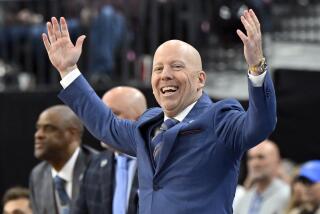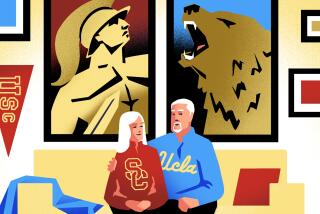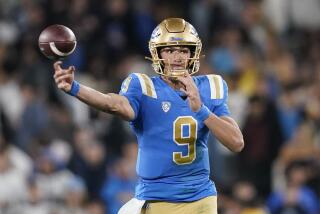Students of TV History Tune In to a Living Textbook
- Share via
The man down front with the booming voice always seemed to have something interesting to say about television’s old days. So students in the UCLA class on TV history knew what to do.
On the laptop computers they were using to take notes at the School of Theater, Film and Television auditorium, they Googled the name Stanley Rubin.
That’s when they discovered that their classmate was a Hollywood pioneer who more than half a century ago won TV’s first Emmy.
These days, the television and film writer and producer with more than six decades of experience is at the Westwood campus polishing off the last few units standing in the way of his bachelor of arts degree -- the one he narrowly missed earning in 1937.
He took a history of film class last fall. And when Rubin, 88, finished this quarter’s TV history course last week, he found himself within four units of graduating.
Many of his 105 classmates took little note of Rubin at first. But that changed when the white-haired man began raising his hand and commenting on everything from stage lighting techniques to Writers Guild disputes to program syndication practices.
“I checked him out online, and this man is great,” said Elias Mael, an 18-year-old film and television major. “It’s unbelievable what he’s done. He’s famous. I was like, wow!”
The computer searches showed classmates that Rubin had served years on the Writers Guild board of directors and spent five years as president of the Producers Guild.
They discovered that Rubin had written 19 movies and produced more than two dozen feature and TV films, as diverse as 1955’s “Francis in the Navy” talking-mule comedy (which gave Clint Eastwood his first credited role) and the edgy “The President’s Analyst” in 1967, starring James Coburn.
Rubin worked with Marilyn Monroe, Robert Mitchum and director Otto Preminger when he produced “River of No Return” in 1954.
He clashed with eccentric studio mogul Howard Hughes in 1951 over “The Whip Hand” and again a year later over the taut film noir “The Narrow Margin.”
His TV producing credits include work with Ronald Reagan in the 1950s and ‘60s series “General Electric Theater.”
It was the pilot episode of a 1948 network TV program called “Your Show Time” that won Rubin the fledgling television industry’s first Emmy. The episode, titled “The Necklace,” won for best film made for television.
Some students -- such as one young man who was writing a term paper that partly involved the 1952 film “Macao,” which Rubin wrote -- have approached him outside class to pick his brain.
Rubin’s own paper for professor John Caldwell’s TV history class was a personal account of “Your Show Time.”
“The ‘Your Show Time’ shows were half-hour dramatizations of what we called the world’s ‘classic’ short stories, which were really the world’s very good public-domain short stories,” Rubin explained.
Rubin’s 20-page term report tells of how the series’ advertising sponsor -- not NBC -- controlled the show.
Most of the scripts that Rubin pounded out in his day ran about 120 pages.
“So this was a piece of cake,” he said of the term paper. “But don’t tell the professor,” he joked.
*
Twice a week, Rubin drives from his home in the hills above the Sunset Strip to class and four hours of lectures and discussions.
Rubin’s most recent film was “White Hunter, Black Heart,” which he co-produced with Eastwood in 1990.
“I’m kind of semi-retired. I suddenly felt I had the time, and I wanted the degree. So I decided to come back to UCLA. I had 14 units to go under the old semester system, but I found that had grown to 18 units under the quarter system,” Rubin said. “I’m learning a lot.”
It was during professor Jonathan Kuntz’s film history class last quarter that Rubin finally understood what happened to him back in 1948 -- when he was bounced from his job as a contract screenwriter at Columbia Pictures.
“I was out of work and it hit me hard,” Rubin said. “What I didn’t know was that hundreds of writers and directors, producers and actors were being dropped because of the Paramount Consent Decree.”
He remembered hearing about the consent decree back then, of course. But he said it wasn’t until the class that he learned that the legal order “forced the Hollywood studios to divorce themselves” from their own theaters.
“They had to sell the theaters, and all of a sudden the studios were saying, ‘We can’t make 40 or 50 or 60 films a year.... We might not get our money back,’ ” he said.
Caldwell said it was somewhat “sobering” to discover Rubin sitting in this quarter’s TV history class -- a sentiment shared by study-session teaching assistant Eric Vanstrom, a 29-year-old film and TV doctoral candidate.
“To a certain degree I was a bit worried about my knowledge base compared with his,” Vanstrom said.
But the old-timer’s gentlemanly style quickly put him at ease.
Indeed, Rubin said he is content being the student -- even when he’s intimately familiar with the subject matter.
“He asks the best questions. He has a rapport with professor Caldwell that the rest of us -- not having any real experience -- don’t have,” said 18-year-old freshman Marshall Knight. “He has the perspective of the life of this industry from spending a life in it.”
Still, Rubin said, “I make a point to myself in class not to talk too much. I try not to take too much class time. And there’s nothing childish about the students. I don’t see it as rubbing elbows with rank amateurs.”
But sitting in class with students young enough to be his grandchildren can yield surprises. Rubin blanched when a 19-year-old freshman said a TV show with a virtual-reality theme “is so dated.” Shrugged Rubin: “I’m experiencing the greatest sense of generational gap I’ve ever experienced.”
Rubin himself delivered one unexpected surprise to the class.
When he learned that the professor planned to screen an episode of the groundbreaking TV comedy series “Bachelor Father,” Rubin brought his wife of 51 years, actress Kathleen Hughes, to class with him.
Hughes is the onetime B-movie blond bombshell known for starring in the 1953 cult classic “It Came from Outer Space.” But she had also worked with “Bachelor Father” star John Forsythe, and Rubin thought she would enjoy seeing him on the UCLA class’ theater screen.
“Unbelievably, the episode that I chose out of the hundreds available was one where she was featured as a guest star,” Caldwell said of Hughes, who appeared in season five, episode 37 of the series. “Afterward I introduced her and she stood up, and there was a standing ovation for her. It was quite fun.”
*
Rubin is eagerly anticipating graduation. He said he missed out on marching with his Class of ’37 peers because he took a smaller class load than he should have in his senior year while he was busy editing the campus Daily Bruin newspaper.
That summer he was hired by Beverly Hills weekly newspaper owner Will Rogers Jr., whose presses had printed the UCLA student newspaper. From there he went to work in the Paramount Pictures mailroom, and his Hollywood career was launched.
Show business has changed a lot since Rubin’s first days at UCLA. But he is quick to tell students that some things haven’t changed at all.
“When I was writing a film, I sat in an office with a typewriter and had meetings with the producer or director. When a writer finished his script, they didn’t want him around anymore,” he said. “The producer liked to think he had written the script. The director liked to think he had written the script. So they got the writer out of there.”
Though he needs only four more units to graduate, no four-unit class is available.
“So I’m taking an eight-unit class next called ‘Hollywood Now’ that picks up on the motion picture business from the mid-1990s on,” he said. “That’s perfect for me. That’s when I left.”
Before his last class, Rubin stopped in at a UCLA photo shop to pick up his graduation picture proof sheet. During a break, he showed the photos to classmates.
“My cap and gown pictures,” he said proudly. “I chose the lower left one.”
More to Read
The complete guide to home viewing
Get Screen Gab for everything about the TV shows and streaming movies everyone’s talking about.
You may occasionally receive promotional content from the Los Angeles Times.







